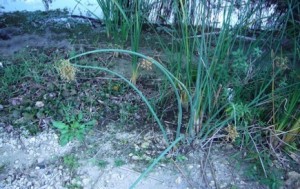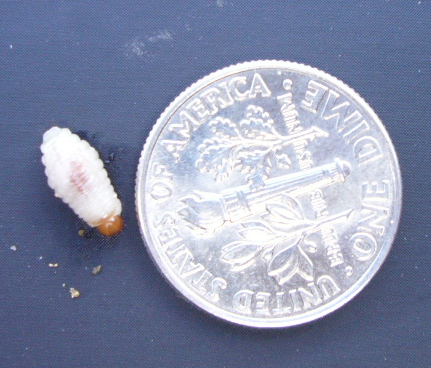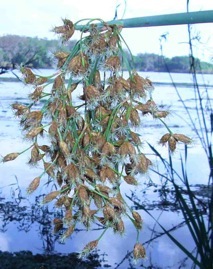Cattail’s Maligned Companion
The bulrush has a public relations problem. It found in the same environment as the cattail, can be used the same way, and tastes better yet one never hears the bulrush praised as much as the cattail. It should be.
Young shoots in spring can be eaten raw or cooked. Its pollen can be eaten as flour in bread, mush or pancakes. The seeds can be parched and consumed or ground and used like flour. The large, horizontal rhizomes roots can be eaten raw or cooked. Indians dried them in the sun then pounded them into flour. The estimated food value is 8% sugar — making it sweeter than the cattail — 5.5% starch 1% protein.
The bulrush, and other edible rushes in the same family (Scirpus validus, SKIR-pus VAL-ih-duh, Scirpus acutus, SKIR-pus uh-KYOO-tuhs) are found throughout North America. The bulrush itself is native across the southern United States to California north to Oregon and south to Argentina and Chile. It’s also found in Illinois, Hawaii, the Cook Islands and Easter Island, where it arrived some 30,000 years ago. Related rushes are found in northern areas and have similar use. Though called a rush the plant is a soft-sided sedge. If you haven’ t heard the rhyme to help you remember the difference between sedges and other plants, here it is: Sedges have edges. All sedges are triangular, some markedly so, other barely so.
One bulrush also has a Latin name you will either like or avoid: Scripus californicus (kal-ih-FOR-nik-us.) Scripus means sharp and refers to the usual edges found on sedges. Californicus means of California. That takes a bit more to explain. In 1772 there was a large lake, some 760 square miles, in what is now the San Joaquin Valley of California. It was discovered by Pedro Fages but no longer exists. Fages named the area Los Tules because of large bulrush marshes. “Tule” probably came from tullin which in Spanish means cattail. The Spanish got it from the Aztec word “Tollin” which meant a group of plants including the cattail, bulrush, and similar plants. Large stands of tules are called tulares.
Tulares are significant wetland habitats for some 160 species of birds and many mammals and amphibians. Marsh wrens and blackbirds build their nests there. Migratory ducks seek food and shelter among the bulrushes. Wading birds forage on fish, amphibians, and invertebrates that hide among the bottom of the bulrushes. Geese feed on the new shoots and roots. Among the birds found in rushes are the bufflehead, mallard, pintail, shoveler, blue-winged teal, cinnamon teal, greater scaup, lesser scaup, avocet, marbled godwit, clapper rail, Virginia rail, sora rail, long-billed dowitcher, tricolored blackbird, canada geese and white-fronted geese. Indians hunted the ducks in the rushes. They would sink nets and make decoys made of rushes. When the ducks landed entire flocks were captured by pulling up the nets.
The Indians cut rushes for mats and thatching for their houses. The thatching is insulating and water-proof. Woven with grape vines, they form floats a person can stand on and pole over water. A similar rush was used by Thor Heyerdahl when he made the Kontiki. Bulrush “shoes” helped hunters to walk over muddy flats without sinking in. Shredded rushes were used to make baskets, baby diapers, sleeping mats, menstrual material, ‘grass’ skirts for the ladies and capes for the men
Like most aquatic plants in the area the bulrush is also home to a beetle grub that fish like. On the bulrush look for a small hole and a brown streak in the upper portion of the stalk. You will find a small grub, actually the larval form of an Arrowhead Beetle. The size will vary but they do grow big enough for a small hook and fish love them. As a weevil the grub is also probably edible by humans but I haven’t got around to trying one. You can find the same grub in the base of cattails. Look for a green cattail with an outer leave that is browing at the bottom.
The bulrush can also be cultivated by planting rhizomes a yard apart in moist rich soil but not standing water. Or, broadcast seed in the same environment, rake in to one-quarter or one-half inch. Seeds are commercially available. Bulrush can be occasionally confused with Pampas Grass. However, Pampas Grass does not like to get its feet wet, has a central ball root system — not a rhizome — and has very sharp edges. Incidentally, when the British use the word bulrush they are referring to the cattail.
There are two large local bulrush that look similar, the S. californicus (Southern Bulrush) and the S. validus (soft-stemed bulrush.) On S. californicus the seeds are reddish brown and feathery, on S. validus the seeds are white and barbed. Saltmarsh Bulrush (Scirpus rubustus) was similarly used. It is found is brackish water, is about three feet tall, has a very triangular, hard stem, leaves that are flat on one side, rounded on the other, and has inch-long spikelets with hooked tipped scales.
Green Deane’s “Itemized” Plant Profile
IDENTIFICATION: When mature 5 to 13 feet tall, leaves are slender, grasslike; stem pithy, long stem. Flowers in a spikelet looking like orange-brown scales. Other Scripus are edible and local varieties vary.
TIME OF YEAR: Shoots and pollen in the spring, seeds, bottoms of stalks and root year best in fall.
ENVIRONMENT: Grows where it is wet, rivers, ponds, ditches, lakes, close to shore or farther out.
METHOD OF PREPARATION: Peeled shoots and roots dried into flour, pollen, seeds starch and sugar, root tips roasted like potatoes. As a Fresh Vegetable: The young shoots and the tender parts inside the base of the stalks are edible raw, or when boiled. The young base roots are also edible both raw and cooked.
Recipies From: http://www.everything2.org/title/bulrush
Roasted Bulrush Roots: Dig up the roots and clean thoroughly, removing all the hair roots by scraping, then wrap in big leaves. Dig a hole in the ground about 18 inches across and 6 inches deep. Build a fire in it, and when you have a good bed of coals, remove most of the coals from the hole and place the wrapped roots in. Scrape the coals back on top of the wrapped roots. Roast for 2 to 3 hours.
Bulrush Stew: Peel the skin off the roots and cut in inch log pieces. place in a pot with boiling water and add a few wild onions or sprigs of mint. Then add pieces of porcupine or other small animals. Boil one hour.
Bulrush Flour: Clean the roots thoroughly and dry them completely in a dry place in the sun. When they are dry, remove the fibers from the root and pound the remaining pulp into a flour. The texture of the flour depends upon how much elbow grease you use in its preparation. It is very sweet.
Bulrush Pancakes: Peel the skin from the roots, cut into small sections, add water, and boil into a gruel. Let cool. Stir in porcupine fat, or any other fat, then add chopped porcupine or bacon. Heat a couple of flat stones over the fire. Form small patties of the mixture and fry on the stones. If berries are in season, mash a cupful and use a compliment.
Bulrush Bread: Skin the roots and cut them into small pieces, the boil in to a gruel. Remove the fibers and let the water evaporate. When all the water is gone you have a sweet-tasting flour. Mix some fat into the flour and mix. Roll the dough mixture out onto a flat rock and bake in a reflector oven. Or make small rolls about 6 inches long and half an inch thick, twist around a stick and set in from of the fire to bake.
Bulrush Broth
Ingredients:
* 1 1/2 pounds oxtail, cut up
* 1 1/2 teaspoons salt
* 1/2 cup flour
* 2 tablespoons bulrush flour
* 2 tablespoons mustard seed
* 2 tablespoons bacon fat
* 6 cups water
* 1/2 cup bulrush shoots
* 3 wild onions
* 1/4 cup wild rice
* 3 bulrush roots, thinly sliced
* 1 tablespoon Worcestershire sauce
Roll the meat pieces in a mixture of flour and salt. Saute them in hot fat, turning several times to brown completely. Add the water, bulrush shoots, and wild onions, then cover and simmer 1 1/2 hours. or until the wild rice is tender.
Bulrush Casserole
Ingredients:
* 1 pound small bulrush sprouts
* 1 pound ground beef
* 1 large onion
* 1 can tomato soup
* 1 cup tomato juice
* Potato chips
* Salt and pepper
The small inner stalks of the bulrush are tender and taste like asparagus when cooked. These stalks are easy to remove from the plant: simply part the leaves and pull the shoots from the roots. Wash them in running water, and cut into small pieces. Soak in salted water.
Mix meat and finely chopped onion, add salt and pepper to taste. In a greased casserole put a layer of bulrush sprouts, then a layer of meat. repeat until all the ingredients are used. Pour the tomato soup over the mixture.
Place in a 425 degree oven for about an hour or until the bulrush sprouts are tender, adding a little tomato juice from time to time to keep it moist. Top with potato chips and let stand in oven ten minutes more. Serves six.
Creamed Bulrush
Ingredients:
* 12 pounds tender bulrush shoots
* 1/2 teaspoon salt
* 1 cup water
* 3 tablespoons butter
* 3 tablespoons bulrush flour
* 3 cups liquid (milk plus drained bulrush juice)
* 1 tablespoon sugar
* 1/4 teaspoon pepper
* Hard boiled egg slices
Rinse the fresh bulrush shoots and steam with salt and water in a covered pan until limp. Drain off all juice into a measuring cup and save.
Chop bulrush shoots finely. melt butter in the top of a double boiler and stir in flour. Gradually add bulrush juice and enough milk to bring total liquid to 3 cups. Stir constantly until smooth. Season with salt and pepper to taste.
Garnish each serving with hard boiled egg slices.
Hunters’ Stew with Bulrush
Ingredients:
* 2 cups finely chopped wild onion
* 2 medium sized bulrush roots
* 10 slices bacon, diced
* 3 pounds boneless beef chunk, cut into 2-inch cubes
* 1 tablespoon finely chopped chives
* 2 cups water
* 1/2 cup dry red wine
* 1/2 teaspoon black pepper
* 1/2 cup dry red wine
* 1 cup wild rice
* 8 bulrush shoots
* 1 1/2 cups beef stock
Skin the onion, chop very fine, and put aside. In a 2-quart saucepan cover the bulrush roots with water, add a pinch of salt, and bring to a boil. Reduce heat and cook for 30 minutes.
Drain water. Scrape and slice bulrush roots in 1/4 inch slices and set aside
In a 12-inch skillet cook the bacon over medium heat until it is crisp. Remove bacon from pan and set on a layer paper towels. Pour off all but a thin layer of fat from the skillet and set the skillet aside.
Add the onions and bring the heat up. Cook until onions are transparent. Add the beef cubes and the rendered bacon fat, then the chives and bulrush roots. Cook for 15 minutes over medium heat. Return the bacon to the skillet. Stir in the water and wine. season with salt and pepper and reduce heat to a low simmer. Cover and cook for about an hour.
Drop wild rice into a quart saucepan. Add a pinch of salt and just enough water to cover. Bring to boil, lower heat and cook for 30 minutes.
Gradually stir the cooked rice, bulrush shoots, and one cup of beef stock into the skillet. Bring to a boil, reduce heat, cover and simmer for 30 minutes.
Taste for seasoning. If the rice becomes too dry, you can add the remaining beef stock to keep it from sticking to the bottom of the pan
Garnish bowl of stew with chopped leeks and parsley. Serves Six





